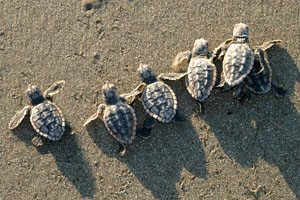
Saving Sea Turtles with SAS’s ConserVision App

In case you missed it, Tuesday was World Turtle Day, as designated by the non-profit organization American Tortoise Rescue. Even if turtle conservation wasn’t on your to-do list this week, the folks at SAS have a way for you to contribute.
Thanks to a collaboration between SAS and the UNC Center for Galapagos Studies, you can help protect endangered sea turtles in the Galapagos Islands. An app called ConserVision allows citizen data scientists (that’s you!) to match images of the turtles’ facial markings to help train a SAS computer vision model to identify the individual turtles.
To participate, visit this website (no sign-up required), read the simple instructions, and start training the AI model by telling it if the turtle on the top of the page is a match for the turtle at the bottom by choosing “match,” “no match,” or “unsure.” You can also supply additional information if the turtle has a visible scar or injury or if the photo is poor quality or at an incorrect angle.
Teaching the model to accurately identify turtles individually through crowd-driven AI gives researchers valuable information to better track each turtle’s health and migratory patterns over periods of time. The goal is that in the future the model can perform facial recognition on any sea turtle image, whether it comes from a conservation group or a vacationing tourist, according to a SAS release.
This project is one of the company’s Data for Good initiatives, in which it uses data and analytics in meaningful ways to solve humanitarian issues around poverty, health, human rights, education, and the environment. It was highlighted at SAS Innovate, the company’s conference in Orlando earlier this month, where Datanami sat down with Sarah Hiser, a principal technical architect at SAS who is also a Master of Science in applied marine ecology.

The ConserVision app’s simple instructions allow anyone to become a citizen data scientist. (Source: SAS)
Hiser explained how this and other crowd-driven data projects can accelerate research and conservation by pairing AI and human expertise, a concept SAS calls “human-centric AI,” which is one of the cornerstones of its Responsible AI ethos.
“I think projects like these are really where it showcases how using algorithms like this can help scale the researcher and scale the person. When helping to figure out turtles that look alike, the computer still needs that bit of human insight to say, ‘This turtle is a different turtle.’”
That’s where humans come in, Hiser said. Sometimes researchers are at the mercy of mother nature when out in the field conducting research, and getting great data on the turtles can be difficult or impossible under certain conditions. This valuable crowd-driven training can multiply their efforts.
Joining our interview was I-Sah Hsieh, principal social innovation manager at SAS who steers its Data for Good projects.
Hsieh anticipates scaling up the project once the algorithm is trained. He noted that once the algorithm is consistent and trusted, it could allow tourists to upload their own photos to continue adding to the researchers’ knowledge.
“Right now, you have two researchers swimming around the Galapagos, taking pictures of turtles, and manually trying to identify them. But you know, every year 350,000 tourists visit the Galapagos, everybody’s got a camera, everybody’s taking pictures of sea turtles. Now think about the scale that we’re going to be able to bring to these researchers and their work,” he said.
Hiser emphasized that accuracy, data quality, and safety are top of mind for this project: “One of the things that SAS is very focused on too is responsible and ethical AI. So if we’re bringing in crowdsourced photos that haven’t already been filtered by the researcher, we want to make sure that we’re removing anything that can be sensitive, pictures of people, kids, anything where there might be someone snorkeling in the background or something, we want to make sure that’s taken care of and out before it gets put into the algorithm itself.”
 Hiser says projects like this sea turtle initiative are special because they create a connection between people and wildlife through technology and make distant aspects of our world more immediate and relatable, which can ignite a sense of wonder and influence future conservation behavior.
Hiser says projects like this sea turtle initiative are special because they create a connection between people and wildlife through technology and make distant aspects of our world more immediate and relatable, which can ignite a sense of wonder and influence future conservation behavior.
“From a researcher’s perspective, we are all conservationists in one way or another. We all want to protect something,” she said. “You’ve got a 16-year-old on a cruise ship going to the Galapagos for spring break with parents, and they take this picture, upload it to Instagram, or find this app. And they say ‘Hey, that’s Stella, the sea turtle, and she’s 46. And she’s been here eight times this year. And later on, you know, that kid is on his boat and thinking about tossing his trash bag, plastic bag over the side, and he thinks twice about it, and doesn’t, because he’s like, ‘Oh, I met this sea turtle today named Stella.’”
Hsieh pointed out that not only is this initiative helping scientists, but from an AI and data literacy standpoint, this project is opening up a whole new world for people who may not have known they can get involved in AI projects.
“That kind of AI literacy and data literacy plants a seed and helps everybody just get a little smarter about this world we live in,” he said.
Get started on your own Galapagos turtle conservation journey at this link.
Related Items:
SAS Innovate Conference Showcases Investments, Partnerships, and Benchmarks
Reggie Townsend Unpacks the SAS Approach to Responsible AI
SAS and IIASA Create Crowd-Driven AI App to Track Deforestation



























